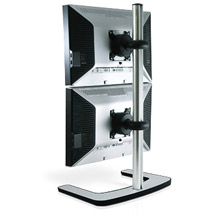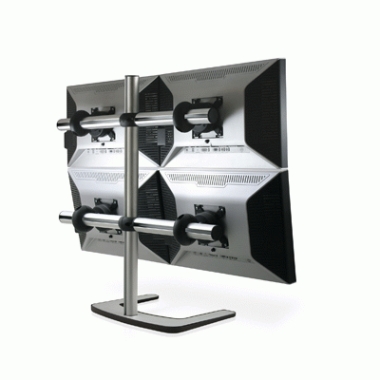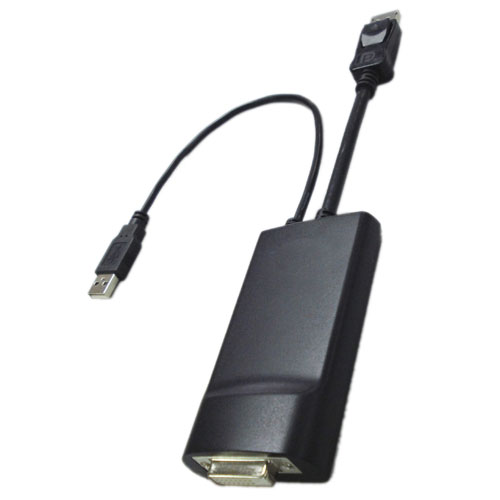AMD Radeon HD 5870 Eyefinity 6 Edition: One Card, Six Screens
Navigating The Obstacle Course
There are two types of challenges facing anyone wishing to take a plunge into the world of what I’ll call the enthusiast multi-monitor desktop. One type relates to the polish missing from certain aspects of the configuration process and the odd software eccentricity. The other type is tied to a hardware ecosystem that hasn’t yet caught up to AMD’s Eyefinity ambitions. The latter is perhaps most problematic, since it's out of AMD's hands.
Before last year, I would have considered anyone with more than two monitors in front of them a unique sort of power user. If they were rocking three or four displays and needed 3D in some capacity, they were probably using two graphics cards. The business-types with up to quad-display requirements were likely looking to a 2D-only card like Nvidia’s Quadro NVS 450.
But the Radeon HD 5870 changed all of that with a trio of easily-accessible outputs. And by the way, three 20” or 22” monitors usually aren’t that difficult to cram onto an average-sized desk (sure beats the price of a 30” or a couple of 24” displays, too).
Addressing Cost
Six monitors present a logistical challenge, though. Hard to imagine in a 6x1 setup, you’re most likely looking at a 3x2 arrangement, which means popping the LCDs off of their bundled stands and onto something sturdier. AMD brought one Atdec VFS-DV (dual) and one Atdec VFS-Q (quad) stand for our hexa-display setup—together, these add almost $450 to the bottom line of our parts list.
The monitors themselves comprise the bulk of the cost. At $229 each, you’re looking at $1,374. Granted, that’s actually less expensive than a single 30” 3007WFP (and and cumulative 5760x2160 output resolution smokes the 30" LCD's native 2560x1600), with significantly more flexibility to be moved around. But they have to go on the tab, nevertheless.
Then there are the cards themselves. AMD is shooting for roughly $480 per Radeon HD 5870 Eyefinity 6 Edition. That’s about $60 more than a 1GB Radeon HD 5870 and just $20 less than a GeForce GTX 480. If you’re serious about playing across six displays at 5760x2160, you’ll probably want to at least consider a pair of these in CrossFire.
Get Tom's Hardware's best news and in-depth reviews, straight to your inbox.
We’re up to about $2,700 in gear between the stands, monitors, and cards. If you already have a handful of similar displays and would rather shave off the cost of LCDs, it is possible to convert the Mini DisplayPort connectors using adapters. AMD is including two Mini DisplayPort-to-DisplayPort dongles, two passive, single-link Mini DisplayPort-to-DVI dongles, and a passive Mini DisplayPort-to-HDMI dongle with the Eyefinity 6 Edition card. But that’ll leave you short no matter what. If you go with six DisplayPort monitors like the ones we’re using, you’ll need four more Mini DisplayPort to DisplayPort adapters or cables at around $20 bucks a pop, given a best-case scenario. Worst-case would be connecting to six dual link DVI-only 30” displays, requiring active Mini DisplayPort-to-DVI adapters at roughly $100 each.
No matter how you roll, six displays are going to be expensive.
Working Efficiently
Don’t think that if upgrading from one to two displays helped you work twice as quickly that going from three to six will have the same effect. There are diminishing returns at work here, and until you sit in front of the sheer wall of desktop real estate that is 5760x2160, it’s hard to imagine taking in that much data at once. Even gaming, I found myself wanting to be about five feet back from the array of displays to avoid looking right and left.
Then again, that didn’t seem to bother Hugh Jackman, so perhaps I’m just getting too damn old.
Current page: Navigating The Obstacle Course
Prev Page Now They're Just Showing Off... Next Page Navigating The Obstacle Course (Continued)-
phantomtrooper I would hate playing with that much black area between screens. I will stick with my 1080p monitor thank you.Reply -
megamanx00 Glad they compared the 1GB and 2GB cards in a 3x1 setup. Glad I got my 5870 instead of waiting for a 2GB card :D. Even so, I want some thin bezel monitors before I hook up three of them. The bezel on my HP LCD is just to think so I'm not keen on buying another two.Reply -
duk3 http://www.newegg.com/Product/Product.aspx?Item=N82E16814125322&cm_re=5870-_-14-125-322-_-ProductReply
Immediate availability? Yes.
Even in stock! (When linked :P ) -
ltcommander_data So I guess Apple's miniDP connector is quite useful after-all and is now seeing adoption outside of Macs.Reply
It's too bad you didn't test GTA IV like you used to do. I believe GTA IV at max settings exceeds 1GB of VRAM usage so perhaps 2GB graphics cards may be of some use assuming the game isn't still CPU limited despite 12 threads with the Core i7 980X. At the very least, I'm guessing Liberty City at 6048x2276 would be amazing. -
oldscotch Obviously, the best solution is a 3x3 grid of displays to make sure your centre focus is not interfered with.Reply
Lesse, that'd be 5760 x 3240.
No sweat ;) -
So, I guess if you already have a 1GB 5870 and 3x1 Eyefinity setup, the only advantage of the 2GB version is being able to pile on the AA/AF effects and still have a playable frame rate.Reply



